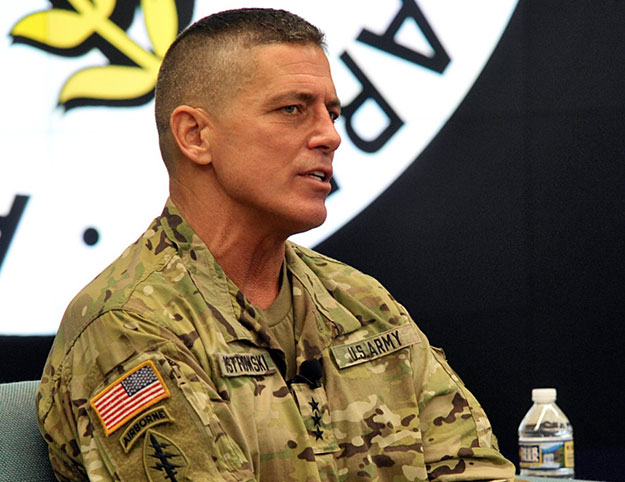The Army plans to add even more firepower to its arsenal of medium tactical vehicles.
The service has been working with the Navy to develop a 100-kilowatt laser weapon, known as a High Energy Laser Tactical Vehicle Demonstrator, to provide air and missile defense to forward-operating locations and airfields, said Lt. Gen. Paul Ostrowski Tuesday morning.
Ostrowski, principal military deputy to the assistant secretary of the Army for acquisition, logistics and technology, told an Association of the U.S. Army audience that the powerful weapon will be based on a platform much larger and more mobile than the 50-kilowatt laser the service plans to bring to the Stryker combat vehicle.
 The Army plans to increase the HEL TVD's power possibly as high as 250 kilowatts.
The Army plans to increase the HEL TVD's power possibly as high as 250 kilowatts.
The project, which has been contracted to Dynetics and Lockheed Martin, is part of the service's modernization priority for air and missile defense. The HEL TVD is expected to be tested at White Sands Missile Range in New Mexico by 2022.
"This is just the beginning of where we're going to see lasers in the future," said Ostrowski, also the director of the Army Acquisition Corps.
Meanwhile, the Army will bring the maneuverable 50-kilowatt Multi-Mission High Energy Laser onto Strykers by 2022, as part of the Maneuver Short-Range Air Defense system. The laser will make M-SHORAD not only more lethal and capable of taking down multiple targets rapidly, but it will also be more cost effective, Ostrowski said.
"The advantage of the laser ... is that we have the ability to have an unlimited magazine when it comes to unmanned aerial systems, as well as rockets, artillery, mortar," Ostrowski said. "Where before we were shooting $100,000 missiles at $7,000 UASs. This puts us in a position where we're not spending that kind of money to do that; we're taking those targets down in a much more rapid fashion and a much cheaper fashion."
Ostrowski discussed plans to test a 50-inch hypersonic missile "booster" stack that will be fired every six to nine months and will eventually evolve into the lighter, more mobile 34.5-inch stack that is compatible with Navy ships.
The general credited Congress with helping put the Army in a position to achieve its modernization goals by improved funding.
"The Army and the rest of the services have been fighting this knife fight with one hand tied behind our back, frankly, for many, many years in terms of acquisition," he said. "And the Hill saw the explosion in technology and the rapid pace at which technology is proceeding. The Hill also saw the fact that our peer and near-peer competitors were catching up to bypass us."
Ostrowski stressed the importance of the service fulfilling its promise to achieve its six modernization priorities: long-range precision fires, next-generation combat vehicles, strengthening the Army's network, future vertical lift, bolstering air and missile defense and soldier lethality.





Read Comments